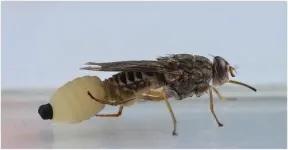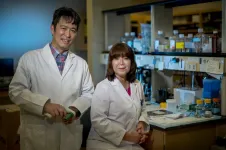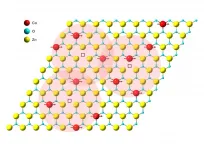(Press-News.org) An international group of researchers representing thousands of coral scientists across the globe is calling for new commitments and actions by the world's policymakers to protect and restore coral reefs.
In a paper presented July 20 at the International Coral Reef Symposium, the scientists said that the coming decade will likely offer the last chance for policymakers at all levels to prevent coral reefs "from heading towards world-wide collapse."
The paper, developed by the International Coral Reef Society, pushes for three strategies to save the reefs: addressing climate change, improving local conditions and actively restoring coral.
"The model projections show that up to 30% of coral reefs will persist through this century if we limit global warming to 1.5 degrees Celsius," said Andréa Grottoli, distinguished professor of earth sciences at The Ohio State University, society president and a contributing author of the paper.
"But if we are to limit warming to 1.5 degrees, we have to do it now: The science and the models show that we have only a few years left to reduce carbon dioxide emissions that put us on that path. It has to happen this decade, or we won't make that target."
Coral reefs are at an inflection point, the researchers say. Stop climate change now - and start to reverse it - and some reefs might survive, with the possibility that they could be rebuilt in the future and provide the seeds to regrow damaged reefs elsewhere.
"From a coral reef perspective, we go from 30% of reefs surviving to only a few percent surviving if we don't act now," Grottoli said. "We are already faced with a grand challenge in trying to restore the reefs. Once we do eventually reduce carbon dioxide emissions and the planet is no longer warming at an accelerated rate, trying to restore from just a few percent is much more difficult."
This year, policymakers from around the world will create updated global frameworks for addressing both of those crises, via the upcoming Conference of the Parties to the United Nations Framework Convention on Climate Change (COP26) and the Conference of the Parties to the Convention on Biological Diversity (COP15). Grottoli said the society created its policy paper to influence those frameworks.
The society's paper makes three asks of policymakers:
Commit to addressing biodiversity loss and the effect climate change has had on coral reefs, ensure policies are ambitious enough to address those crises, and ensure that policies are implemented.
Build coordinated actions across related policy fields at all levels of governance, from local councils to international bodies. This includes efforts in conservation, management and restoration, as well as policies that address climate change adaptation, biodiversity and sustainable development.
Innovate new approaches to help coral adapt to climate change. Global warming is here, and adaptation is unavoidable. A small percentage of reefs and some coral species have been successfully managed. "Studies of these 'bright spots' provide important lessons to guide future actions, such as how local community participation can improve management outcomes," the scientists wrote.
"As bad as climate change has been for the last decades, we also have lost vast amounts of coral reefs through overfishing, pollution and other local actions, and we need to tackle both of those fronts simultaneously," said Nancy Knowlton, lead author of the paper and Sant Chair for Marine Science Emerita at the Smithsonian Institution's National Museum of Natural History.
"Climate change is important but it's important that these other things aren't neglected. There's no time for arguing about which is most important; we need to do all of them."
Coral reefs are crucial ecosystems, housing about a third of the known ocean species despite covering less than 0.1% of the world's oceans. They are also critical for local food supplies and economies. Reef-related tourism alone generates some $36 billion per year and the global economic value of reefs across all sectors approaches $10 trillion per year.
They are sources for important biochemical compounds, including drugs that treat cancer.
And they protect coasts from storm flooding: A healthy reef can break waves and buffer more than 90% of incoming wave height and energy. In the United States and its territories alone, according to the ICRS paper, the annual value of flood risk reduction provided by coral reefs is more than 18,000 lives affected by flooding and $1.8 billion. Without reefs, researchers have estimated that annual flood damage would more than double, and that flooding would increase by 69%.
But reefs are particularly susceptible to the negative effects of climate change, which causes ocean temperatures to increase and ocean waters to acidify. Those environmental changes can cause coral to bleach, stop growing and die.
"The window for opportunities to act both on coral reef adaptation and on climate change mitigation will soon close for good," said David Obura, contributing author to the paper and director of CORDIO East Africa, a nonprofit research organization focused on coral reefs and sustainability in Africa. "We need a massive increase in commitment now and even more in coming years, coherence across all scales and jurisdictions, and innovation - new mindsets, approaches and techniques. More than anything we need everyone to act, including us scientists by providing our approaches and knowledge, to do our part in saving coral reefs."
INFORMATION:
The ICRS policy paper was authored by scientists from the U.S., Africa, Europe, the Middle East and Australia. The mission of the ICRS is to promote the acquisition and dissemination of scientific knowledge to secure the future of coral reefs, including via relevant policy frameworks and decision-making processes. The policy statement released in coordination with the 14th International Coral Reef Symposium is the most comprehensive in the society's history.
The full document, along with translations of this press release and the paper's executive summary (Spanish, German, French, Portuguese, Arabic and Mandarin), are available online at http://coralreefs.org/publications/rebuilding_coral_reefs/
CONTACTS: Andrea Grottoli, grottoli.1@osu.edu
Nancy Knowlton, knowltonn@gmail.com
David Obura, dobura@cordioea.net
Heinz Krimmer, heinz.krimmer@icrs2021.de
Written by Laura Arenschield, arenschield.2@osu.edu
The female tsetse fly, which gives birth to adult-sized live young, produce weaker offspring as they get older, and when they feed on poor quality blood.
The study, carried out by researchers at the Universities of Bristol, Oxford and the Liverpool School of Tropical Medicine, was designed to measure how tsetse offspring health is influenced by their mothers' age, and how factors such as the mother's nutrition and mating experience might come into play.
In many animals, females show signs of reproductive ageing - where offspring health declines with maternal age - but there is huge variation within species in how rapidly this ageing occurs.
Scientists found that female tsetse that experience ...
For more than 20 years, Makoto Miyata from Osaka City University has been studying the gliding motility of the parasitic bacterium Mycoplasma mobile (M. mobile). It is a mechanism consisting of an external "grabbing" structure and internal "motor" - the motor having yet to be clarified on a molecular level. In collaboration with Osaka University and Kanazawa University, his research team used electron microscopy and high-speed atomic force microscopy (high-speed AFM) to reveal that the bacteria's molecular motor consists of two ATP synthase-like complexes, suggesting an unexpected evolution of the protein. Their findings were published in mBio.
Based on genetic information, researchers have suggested that the ...
Imagine you're a CEO who wants to promote an innovative new product -- a time management app or a fitness program. Should you send the product to Kim Kardashian in the hope that she'll love it and spread the word to her legions of Instagram followers? The answer would be 'yes' if successfully transmitting new ideas or behavior patterns was as simple as showing them to as many people as possible.
However, a forthcoming study in the journal Nature Communications finds that as prominent and revered as social influencers seem to be, in fact, they are unlikely to change a person's behavior by example -- and might actually be detrimental to the cause.
Why?
"When social influencers present ideas that are ...
A new scoping review found that those with chronic health concerns, such as diabetes, heart disease, cancer, and autoimmune conditions, are not only at a higher risk of severe COVID-19 infection, they are also more likely to experience anxiety, depression or substance use during the COVID-19 pandemic.
The aim of the review was to address knowledge gaps related to the prevention and management of mental health responses among those with chronic conditions. The findings, recently published in the International Journal of Environmental Research and Public Health, were based on a comprehensive review of 67 Chinese and English-language studies.
"Levels ...
A recent study in Frontiers in Sustainable Food Systems shows that the fruits of a type of tomato plant send electrical signals to the rest of the plant when they are infested by caterpillars. Plants have a multitude of chemical and hormonal signaling pathways, which are generally transmitted through the sap (the nutrient-rich water that moves through the plant). In the case of fruits, nutrients flow exclusively to the fruit and there has been little research into whether there is any communication in the opposite direction--i.e. from fruit to plant.
"We usually forget that a plant's fruits are living and semiautonomous parts of their mother-plants, far ...
ANN ARBOR, Mich. - As children made fewer visits to health facilities and engaged in social distancing and other COVID-19 mitigation measures, a smaller number of them also received prescription drugs, a new study suggests.
Overall, medications prescribed for children dropped by more than a quarter during the first eight months of the pandemic compared to the previous year, with the steepest declines in infection-related medicines like antibiotics and cough-and-cold drugs.
Antibiotic dispensing to children and teens plunged by nearly 56 % ...
An internal transporter that enables us to use the copper we consume in foods like shellfish and nuts to enable a host of vital body functions also has the essential role of protecting the receptor that enables us to grow new blood vessels when ours become diseased, Medical College of Georgia scientists report.
The findings published in the journal END ...
The development of an ultrathin magnet that operates at room temperature could lead to new applications in computing and electronics - such as high-density, compact spintronic memory devices - and new tools for the study of quantum physics.
The ultrathin magnet, which was recently reported in the journal Nature Communications , could make big advances in next-gen memories, computing, spintronics, and quantum physics. It was discovered by scientists at the Department of Energy's Lawrence Berkeley National Laboratory (Berkeley Lab) and UC Berkeley.
"We're ...
Black holes with masses equivalent to millions of suns do put a brake on the birth of new stars, say astronomers. Using machine learning and three state of the art simulations to back up results from a large sky survey, the researchers resolve a 20-year long debate on the formation of stars. Joanna Piotrowska, a PhD student at the University of Cambridge, will present the new work today (Tuesday 20 July) at the virtual National Astronomy Meeting (NAM 2021).
Star formation in galaxies has long been a focal point of astronomy research. Decades of successful observations ...
The case of a patient who experienced two facial palsies - one after the first and another after the second dose of the Pfizer-BioNTech COVID-19 vaccine - strongly suggests that Bell's palsy (facial nerve palsy of unknown cause) is linked to the Pfizer-BioNTech vaccine, doctors write in the journal BMJ Case Reports.
They describe the first case to be reported in the medical literature of two separate unilateral facial nerve palsies, where muscles on one side of the face become weak or paralysed, occurring shortly after each dose of a COVID-19 vaccine.
"The ...



